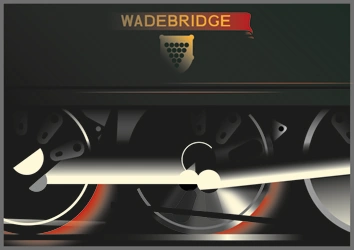Dave Mitchell was the Engineering Director of Wadebridge (34007) Locomotive Ltd and was responsible for overseeing the restoration of Wadebridge from scrap condition to full operation. He works for Southern Locomotives at Swanage, knows an awful lot about Bulleids and is a self-styled "Bulleid Fundamentalist"!
"As a Bullied Fundamentalist I do try to be pragmatic about what Bullied was trying to achieve when he designed his locomotives. I write the following to explain the real reason why the lagging on the boilers of the Bullied Pacifics became soaked with oil and subsequently caught fire. This will, I hope, dispel all the mythical rubbish that has been written about the oil baths fitted to Bulleid's pacifics. A few years ago, when in conversation with the late Harry Frith senior, he explained to me the root cause of all the trouble. Harry had finished up at Eastleigh works as Chief Erecting Shop Foreman, where these locos were repaired, and therefore was well qualified on the subject.
The driving axleboxes are lubricated from missionary trays located in the cab via trimmings which are feeding oil all the time that the trimmings are in. Consequently, when the loco is standing (e.g. in a station or inbetween duties etc.) oil would run out of the axleboxes, most of which ended up in the wheel pockets of the BFB wheels - bear in mind that there are four feeds per axlebox. On starting away the oil was flung up under the casing and into the lagging. With time it also attracted brake block and ballast dust etc., thereby providing the fuel!
The source of ignition was a heavy brake application, which threw up sparks and ignited the gasses from the sump breathers which, in turn, set fire to the lagging. A regular supply of the oxygen that is so essential for good combustion was drawn up under the casing, aided and abetted by the loco's forward movement.
What was done to prevent it? The material the brake blocks were made of was changed to a different grade of cast iron which reduced the sparking and the boiler had belly lagging sheets fitted to the underside which encapsulted the lagging. The first ten Merchant Navies were fitted with splashers, but these, presumably to save weight, were discarded for all the other locos. Steam cleaning was introduced (pictures exist of this being carried out) and the problem was drastically reduced by these preventitive measures. You don't read so much about the fires that occurred on the class 47s, which were prone to catch fire for similar reasons!
Yes, the oil baths did crack, but you must remember that the 40 gallons of oil contained therein when the loco was on the move was being pumped via an oil gallery and ejected through spray pipes over the motion. The excess oil ran down the sides of the oil bath, some did, obviously, exude from the cracks, but not in the copious quantities that you read about. The significant loss of oil would have occurred through the breathers, as gassing would be constant.
One final point, if you were to use a Ferrarri to get to work instead of your Fiesta, say, then would you not expect to use more fuel? They might have hauled one or two coaches one way, but often as not they came back with 10 or 12. I find it hard to believe how petty and small minded people can be with regard to these locos, but maybe fame attracts controversy and jealousy? Yes, the problems that were encountered were unique, but what of it? The Bullieds were exceptional locomotives.
It also must be noted what Bullied was trying to achieve in the short space of time he had in the post of CME. All things considered I think he and his team did very well with the resources they had, coping with his original ideas and methods of working."
